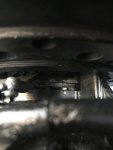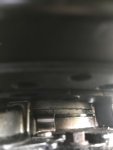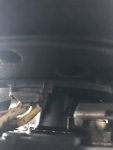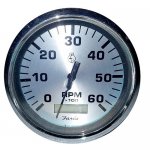Visually inspect the stator under the flywheel closely to see if it is dripping a sticky looking substance down on the timer base and powerhead. If it is, replace it as that results in a voltage drop to the powerpack capacitor that will lead to weak, erratic, and eventually no ignition.
It also usually coincides with a failing voltage regulator/rectifier assembly that interferes with the tachometer function (as you describe)
You can check the tachometer as follows which will give you an idea of the other components status.
********************
(Testing Tachometer With Water Cooled Regulator/Rectifier)
(J. Reeves)
A quick check is to simply plug in a another new tachometer as a piece of test equipment. If the new tach works properly and the old tach didn't, obviously the old tach is faulty.... but usually boaters don't carry around a spare tach (see below).
A faulty rectifier wouldn't damage the tachometer, the tachometer simply wouldn't work. This is due to the fact that the tachometer operates off of the charging system and the rectifier converts AC voltage to DC voltage, enabling the charging system. A faulty rectifier disables the charging system, and the tachometer simply doesn't register.
However.... those water cooled regulator/rectifiers that are used on the 35 ampere charging systems (and some others) bring into play a different type problem, and as you've probably found out, they are really a pain to troubleshoot via the proper procedure. There's an easier way.
The tachometer sending/receiving setup operates off of the gray wire at the tachometer. That same gray wire exists at the engine wiring harness which is connected to the engine electrical terminal strip. You'll see that there is a gray wire leading from the regulator/rectifier to that terminal strip, and that there is another gray wire attached to it. That other gray wire is the wire leading to the tachometer which is the one you're looking for.
NOTE: For the later models that DO NOT incorporate a wiring terminal strip, splicing into the "Yellow Wire" mentioned will be necessary.
Normally the Gray wire leading from the tachometer is attached at the terminal strip to another Gray wire which leads from the water cooled voltage regulator/rectifier...... remove the gray wire that leads to the tachometer. Now, find the two (2) yellow wires leading from the stator to that terminal strip. Hopefully one of them is either yellow/gray or is connected to a yellow/gray wire at the terminal strip. If so, connect the gray wire you removed previously to that yellow/gray terminal. Start the engine and check the tachometers operation, and if the tachometer operates as it should, then the regulator/rectifier is faulty and will require replacing. If the tachometer is still faulty, replace the tachometer.
If neither of the yellow wires from the stator is yellow/gray, and neither is attached to a yellow/gray wire, then attach that gray tachometer wire to either yellow stator wire, then the other yellow wire, checking the tachometer operation on both connections.
I've found this method to be a quick and efficient way of finding out which component is faulty.... the tachometer or the regulator/rectifier. It sounds drawn out but really only takes a very short time to run through. If the water cooled regulator/rectifier proves to be faulty, don't put off replacing it as they have been known to catch on fire with disastrous consequences.
********************
























